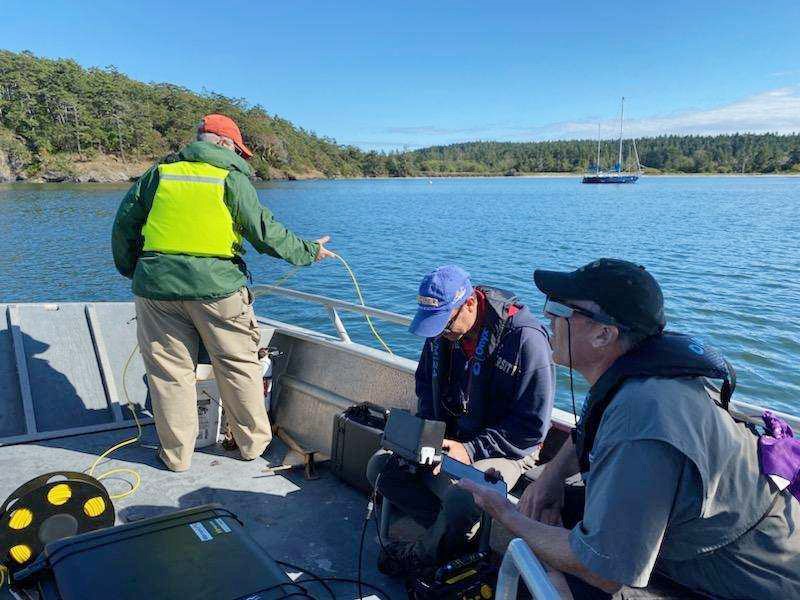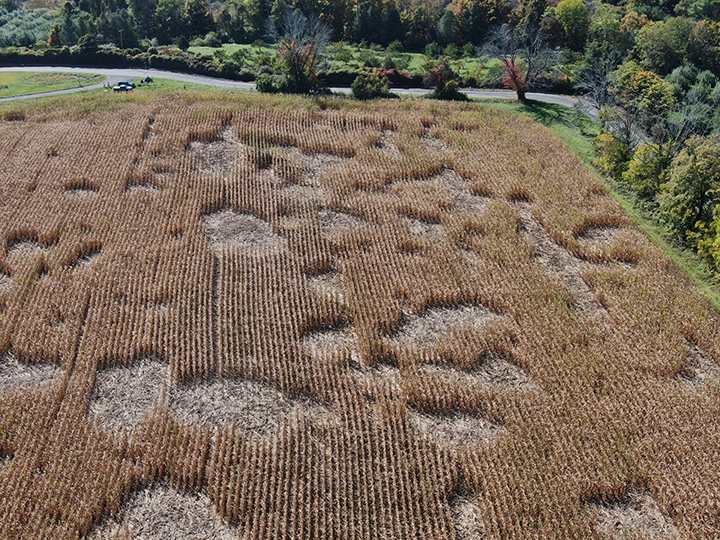Trudging in inclement weather through miles of corn fields to study crop damage caused by hungry bears has not been Stephen Komar’s favorite task.
As an associate professor and agricultural agent with Rutgers Cooperative Extension (New Jersey), he’s accustomed to being outside on farmland, but this is sometimes tedious work – miles of walking loaded down with a backpack full of GPS devices and other equipment. And sometimes there are surprises.
“At least four times I’ve come into an area where there was damage – and the bear was still there enjoying a meal,” he says. “That made this research even less appealing.”
But a unique collaborative relationship between his department and the drone program at Warren County Community College (WarrenUAS) can eliminate the risk of running into the big black source of the problem. Also, drones can dramatically speed up the research on the surprisingly prevalent bear damage and the whole nagging issue of wildlife encroachment on farmland with even more accurate results.
“It might take me half a day to walk through a cornfield. With the equipment at WarrenUAS and our background in this area, we can get even better information with a drone flying over 20 acres for just nine minutes.” Komar says.
The collaboration grew out of discussions between Komar and Warren President Will Austin, who has been a dogged advocate for the college’s drone program, even taking a year’s sabbatical to help build it. It is now considered one of the best schools in the country for training students to build, program, fly and maintain drone technology – with what Komar and others say is perhaps the broadest collection of drone equipment at any facility in the country. It is now housed in a new Dr. Joseph Warren Robotics Research Center and other renovated space on the school’s campus in Phillipsburg, New Jersey.
An opportunity
Austin says the collaboration allows Warren to expand its precision agriculture program and build it as a valuable resource to farmers by finding answers to the latest real-world issues they face.
“Rutgers is doing that leading-edge agricultural research and expressed an interest in our expertise with drone and robotic technology,” Austin says. “The beauty of it is that we really are bringing something of value to them – not just providing them with students. I believe more community colleges can offer programs of value to bachelor’s degree-granting schools, and it’s something these universities are seeking.”
WarrenUAS has grown rapidly in the past seven years, next fall enrolling 80 to 100 students who will have an opportunity to work with its $5-million worth of drone and robotic equipment, including the latest technology such as advanced multispectral sensing, aerial robotic spraying and treatment, and data processing through artificial intelligence. Additional advancements in research capacity, equipment and the ability to design, fabricate and program unique one-of-a-kind robotic drones are expected this year thanks to an anticipated congressional appropriation from New Jersey’s U.S Senators, Austin noted, adding to the capacity for collaboration.
Austin points out that two of Warren’s 2024 graduates are already working prior to graduation at starting compensation of $110,000 each to use what they learned at WarrenUAS.
The program is collaborating with other colleges, along with building connections to a variety of other organizations in the field and in the community. For example, it has a partnership with the leading aeronautical university in the country, Embry-Riddle, based in Daytona Beach, Florida. The schools are working together on projects ranging from law enforcement training to spotting the more than 300,000 invasive pythons living in the Everglades.
Valuable in new ways

Embry-Riddle has highlighted the relationship in its own promotional material, noting that the WarrenUAS program has “top-notch” equipment and a critical focus on training its students to prioritize safety.
“We are able to collaborate very effectively on important projects in the field and give students from both our schools valuable opportunities to work in real-world situations, ,” said Joseph Cerreta, an associate professor in Embry-Riddle’s college of aeronautics, who focuses on the drone flight training program. “Beyond that, the relationship creates a connection where we can share the latest information in the field and create a pathway for Warren students to move into our program to complete their four-year degree, benefiting them and both institutions.”
Austin and his team at Warren are also developing a relationship with Delaware Valley University in nearby Doylestown, Pennsylvania. This summer, that partnership will bring Delaware Valley’s agriculture program and the WarrenUAS drone expertise together to benefit students on both campuses and the institutional knowledge on each.
“I really believe there are a lot of ways that community colleges can be real partners with four-year schools – offering special programs that the bachelor-degree granting institution doesn’t have or providing an introduction to a field that would allow the four-year school to focus more resources on advanced training,” Austin says.” It’s a different type of relationship than one where our students just transfer out and our value is in providing four-year colleges with enrollment prospects.”
The “academic capacity” of community colleges needs to be shared more broadly, according to Austin: “We have more capacity than we often realize, and we need to leverage that to better strengthen our university partnerships.”
Austin sees opportunities for community colleges to focus on certain specific training in medicine, information technology or construction, for instance, which would provide students with a marketable skill and also background to move on to the bachelor’s degree. They might seek a full nursing degree, for instance, as they moved from a community college-based program in one portion of patient care.
“This isn’t a one-off, short-term project or something that just looks good on paper for a while – it’s a real partnership with colleagues working together and using the strengths of two institutions to benefit each of them and the students at both schools,” Austin says. “In that way, it can be very valuable to a community college like ours and greatly benefits our students.”
The drone-farm blend
That’s how it has worked in the WarrenUAS collaboration with Rutgers.
Adam Kyle, a recent graduate of Embry-Riddle who heads up the WarrenUAS precision agriculture program, says that not only will the college’s students get to work on real-world projects with the four-year schools, but they will have an easier pathway to get their bachelor’s degree there or enter the industry at livable wages.
“We had something Rutgers didn’t have – this access to drones and their capacity to do mapping and multispectral photography,” he says. “They had the expertise in agronomy that could benefit us as we explore the best ways to use drones in agriculture. But then, in addition, our students also have a pathway to a four-year or advanced degree.”

More effectively documenting crop destruction by bears, who in one case ruined 20% of a 20-acre farm field, can help farmers in their insurance claims or yield estimates and can be passed along to state officials dealing with wildlife management. Deer are another perhaps bigger problem that can be assessed.
But Kyle and his team are also gathering data from drones for other research Rutgers is undertaking on its 390-acre laboratory farm, where they are studying issues such as the impact of solar panels on farmland, the potential for hemp production and its use in recyclable materials and various methods of tilling. Komar says the drone-based equipment can accurately measure growing conditions and plant health in some of the one-acre plots where the Rutgers research is undertaken and report on how variations in methods are working.
“We can fly over a field, take a picture with a multispectral camera, and see what is happening in that field at that time,” Komar says. “Certain readings might show plants in an area, for instance, may have a nutrient deficiency. We could then make fertilizer applications only where needed and potentially do it more precisely and quickly with a drone.”
The technology not only can save the farmers time and money, which is critical for the smaller farms in New Jersey, it can greatly decrease the use of materials that might be considered harmful to the environment.
“There are a lot of exciting ways we believe drones can benefit farmers, and that’s really our mission,” says Komar.
Austin agrees.
“We are just discovering some of opportunities for both of us to learn and to expose our students to real-world issues in agriculture,” he says. “Community colleges can perhaps find ways they can offer four-year institutions expertise and trained students, which can build a different kind of relationship between the two.”

